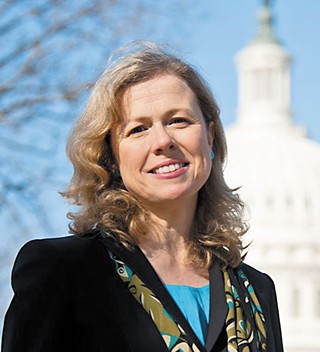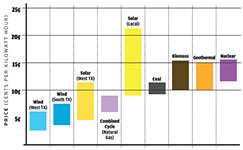Adapt or Fry: UT Climate Adaptation Symposium
Climate Resilience and Adaptation Strategies: A Capital Area Symposium
By Brandon Watson, Fri., Sept. 27, 2013
Stories of surviving Austin's summers usually include a bit of melodrama; the triple-digit heat lurks like a mustache-twirling villain, leaving locals feeling as helpless as damsels in distress. But a Texas heat wave and global climate change are very different antagonists. The organizers of next week's Climate Resilience and Adaptation Strategies Symposium at UT's LBJ School know that the looming threat of global warming may be impossible to avoid – but every melodrama needs a hero. Immediate action may be the thing that keeps us all from being tied to the tracks.
As a strategy, adaptation may seem obvious, but it also represents a sea change in climate change thought. When a broad consensus on the causes of global warming was reached in the Nineties, most of the corrective action focused on mitigation – either through reducing greenhouse gas emissions or removing them from the atmosphere. Climate adaptation accepts that much of those efforts have been too little, too late. Instead of rehashing doomsday scenarios, or focusing solely on mitigation, adaptation proponents argue that we should be planning now for the challenges ahead.
Unlike mitigation strategies, which often rely on federal legislation, adaptation strategies often are most effective at the local level. The symposium's keynote speaker, Georgetown Climate Center Executive Director Vicki Arroyo, listed several examples of solutions in place during her 2012 TED talk – from houses built on stilts in the aftermath of Hurricane Katrina to green roofs installed after the deadly 1995 Chicago heat wave. The UT conference aims to bring the message to Central Texas.
Forum organizer Stefan Wray says a primary goal is awareness. "There's definitely activity around climate mitigation," Wray says, "Austin has had a climate mitigation policy since 2007. But as far as adaptation, for our region it's somewhat new." That doesn't mean Austin is completely behind the curve. "All the work that the Austin utility does on water conservation could be considered [adaptation]. Planting trees is considered to be one of the techniques for urban resilience to the heat island. When that happened, it was not necessarily happening underneath the rubric of a resilience plan."
Wray hopes this symposium will spur local officials to expand climate policy to address adaptation. Wray says he wanted to "encourage the city of Austin itself acting within the region, since it is a leader in the climate mitigation arena, to also develop a policy around resilience and adaptation that is more formally recognized by City Council." Toward that goal, Wray cast a wide net in developing the invitation list, including not only local and regional bigwigs but also influencers targeted through Austin's Office of Sustainability.
The symposium was already on the radar of at least one local policymaker: City Council Member Bill Spelman. Wray says the idea grew out of an assignment that he and fellow LBJ graduate student (and former Chronicle staffer) Nora Ankrum completed for Spelman's Policy Development course. Indeed, Wray lists UT as a good resource already in place for policymakers. "There's a lot of knowledge at the University of Texas about climate change, even somewhat about climate adaptation and resilience," he says, "I think that building those links between the academic community and local government is important."
Important too is that the links can circumvent a state government that does not exactly warm to the climate change discussion. "There's a lot that can be done without necessarily having to involve that layer," Wray says. "For example, Austin and CAMPO [Capital Area Metropolitan Planning Organization] have recently collaborated to get a Federal Highway Administration grant to do a climate vulnerability study of the transportation network here in Central Texas. They navigate around it by applying directly to the federal government for these grant funds. I hope that over time we'll get leadership at the state level that will recognize this as well. There has been legislation introduced by [Fort Worth Rep.] Lon Burnam in the last two sessions ... for there to be some kind of statewide adaptation plan – it failed both times."
Climate adaptation strategies largely leave partisan politics to one side of the discussion. "There may be people, when they hear the words 'climate change,'" Wray says, "who might automatically put up blinders and have some sort of immediate reaction to that. Even more so, if you're trying to suggest that the change of climate is an anthropogenic problem, they may say 'no, no it does not have anything to do with humans.' Regardless, people recognize that something is changing. I think that's the thing about focusing on adaptation that's different. Mitigation deals with the fact that there are CO2 and other greenhouse gas emissions that we need to curb. You can be focusing on climate adaptation and not necessarily get into the argument of what the actual cause is."
Friday, Oct. 4, 8:30am-6:30pm
LBJ School of Public Affairs, 2300 Red River
Register ($40) at www.txclimadapt.com
9:15am: Opening Remarks: Katharine Hayhoe
9:45am: Regional Climate Change Projections & Impacts
11:00am: Vulnerabilities and Risks in the Capital Area
1:00pm: Climate Adaptation & Resilience Planning in Austin
2:45pm: Regional Approaches to Climate Resilience
4:30pm: Keynote: Vicki Arroyo
Climate Resilience and Adaptation Strategies Symposium
Got something to say on the subject? Send a letter to the editor.











